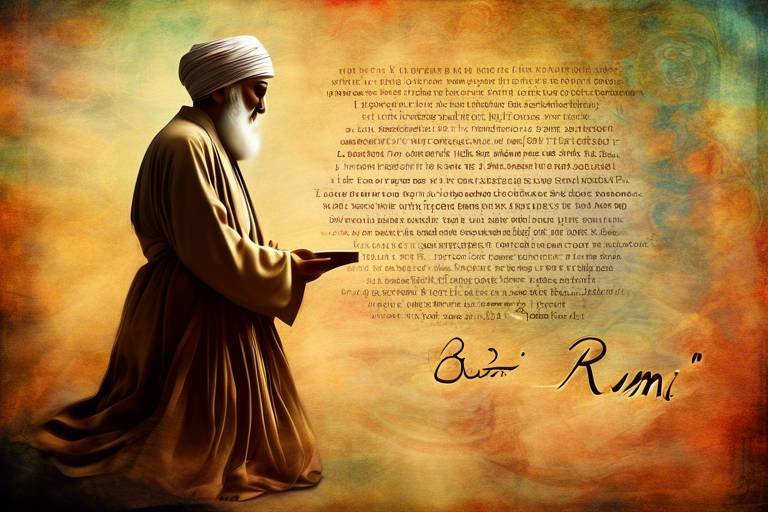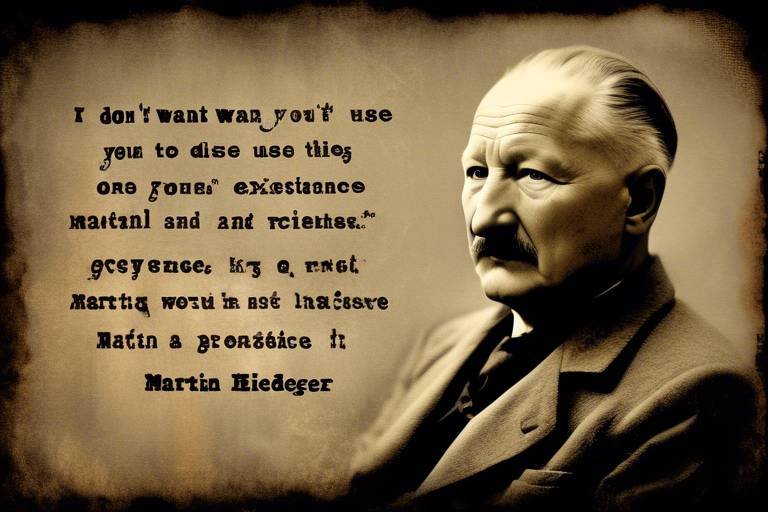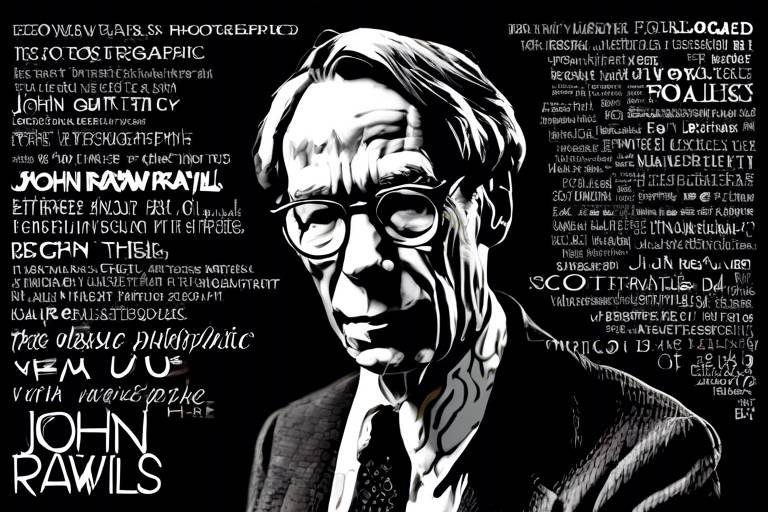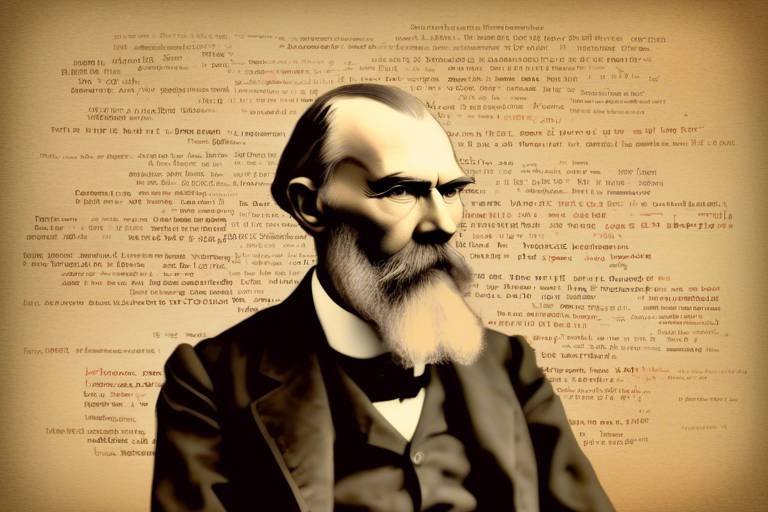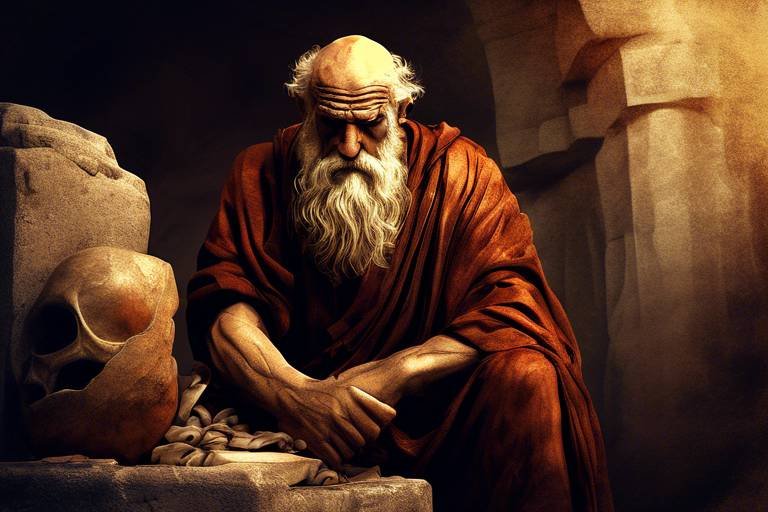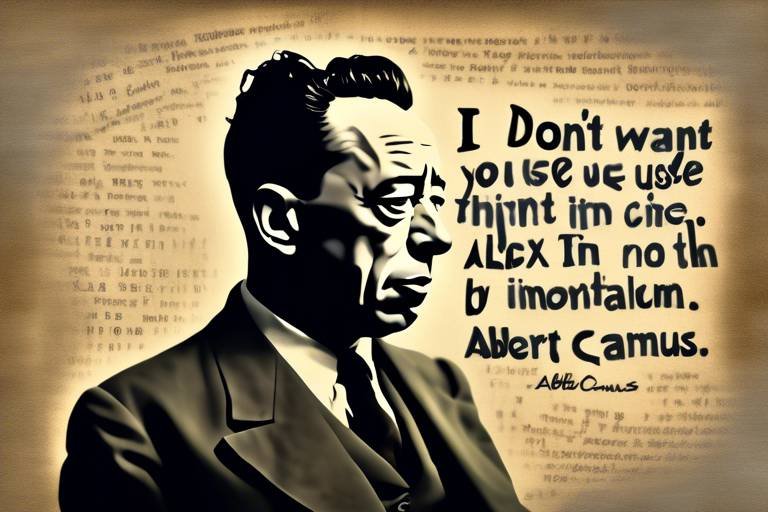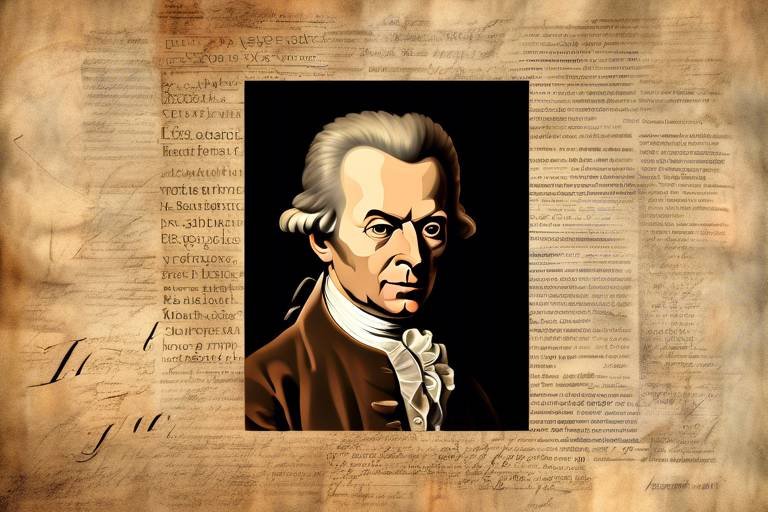Unveiling the Mystical Philosophy in Rumi's Poetry
Rumi, a name that resonates with the echoes of love, spirituality, and profound wisdom, has captivated hearts and minds for centuries. His poetry serves as a gateway to understanding the mystical dimensions of life, inviting readers to embark on a journey that transcends the mundane. With every verse, Rumi unveils a tapestry woven with the threads of divine connection, urging us to explore the depths of our own souls. It's like stepping into a realm where the boundaries between the earthly and the divine blur, and we are encouraged to embrace the beauty of existence.
At the heart of Rumi's work lies an exploration of the human experience, where love is not merely an emotion but a transformative force that connects us to something greater than ourselves. Imagine love as a bridge, stretching across the chasm of separation, leading us to the shores of unity with the divine. Rumi's poetry is a celebration of this love, portraying it as a powerful energy that can heal, uplift, and illuminate our paths.
But what makes Rumi's poetry so enchanting? It's his ability to articulate complex spiritual truths in a way that feels both personal and universal. He speaks to the seeker in all of us, offering insights that resonate deeply with our own experiences. Whether you find yourself in moments of joy, sorrow, or contemplation, Rumi's words have a way of wrapping around your heart like a warm embrace, reminding you that you are not alone on this journey.
As we delve deeper into Rumi's mystical philosophy, we discover that his work is not just about the pursuit of love and divine connection; it's also about the journey of the soul. Rumi illustrates this journey with vivid imagery and metaphors, inviting us to reflect on our own paths toward enlightenment. Each poem acts as a mirror, reflecting our innermost thoughts and feelings, encouraging us to embark on a quest for self-discovery and spiritual truth.
In essence, Rumi's poetry is a roadmap for anyone seeking to understand the complexities of existence. It challenges us to confront our fears, embrace our vulnerabilities, and ultimately, to seek unity with the divine. So, as we explore the themes of love, suffering, and spiritual growth in Rumi's work, let us keep our hearts open and our minds curious, ready to uncover the wisdom that lies within his enchanting verses.
- What is the main theme of Rumi's poetry?
Rumi's poetry primarily revolves around love, spirituality, and the quest for divine connection. - How does Rumi view suffering?
Rumi sees suffering as a necessary catalyst for growth and deeper understanding of the divine. - What role does nature play in Rumi's work?
Nature is often intertwined with spirituality in Rumi's poetry, serving as a metaphor for profound truths about existence. - What is Sufi mysticism and how does it influence Rumi's poetry?
Sufi mysticism emphasizes the pursuit of divine love and knowledge, greatly influencing Rumi's poetic vision.

The Essence of Love in Rumi's Work
Rumi's poetry is a vibrant tapestry woven with threads of love, depicting it not merely as an emotion but as a profound force that transcends the boundaries of the physical world. His verses evoke a sense of connection that resonates deeply within the human spirit, urging us to explore the divine love that exists beyond our earthly experiences. Love, in Rumi's eyes, is a bridge that connects us to the universal truth, a sacred thread that binds all of creation together.
At the heart of Rumi's work lies the idea that love is the ultimate expression of our existence. It compels us to seek deeper meanings and to embrace the mystical journey of life. In his poetry, love is portrayed as a transformative power, capable of elevating the human soul to new heights. Rumi often writes about the ecstasy of love, which can lead to a state of spiritual awakening. It's as if he is saying, "When you love deeply, you touch the divine." This perspective invites readers to reflect on their own experiences with love and how it shapes their understanding of the world around them.
Rumi's exploration of love can be categorized into several profound themes:
- Divine Love: Rumi emphasizes that love is not only a human experience but also a reflection of the love of the divine. This connection is what drives the soul towards enlightenment.
- Love as a Journey: He illustrates love as a journey, where each experience brings us closer to understanding our true selves and our place in the universe.
- Universal Love: Rumi's poetry transcends cultural and religious boundaries, inviting everyone to partake in the universal experience of love.
In his famous poem, "The Masnavi," Rumi beautifully encapsulates the essence of love with lines that resonate across time and space. He writes, "The wound is the place where the Light enters you," suggesting that through our experiences of love—both joyous and painful—we can find healing and enlightenment. This metaphor serves as a reminder that love is multifaceted; it can bring both joy and sorrow, yet it is through these experiences that we learn to embrace the fullness of life.
Moreover, Rumi's portrayal of love extends to the relationships we cultivate with others. He emphasizes the importance of authentic connections, urging us to engage with those around us in a way that fosters understanding and compassion. Love, in Rumi's philosophy, is not possessive; rather, it is liberating. It encourages individuals to express their true selves, creating a space where both partners can grow and flourish.
In essence, Rumi's poetry serves as a guiding light, illuminating the path to understanding the profound nature of love. His words remind us that love is not merely an emotion but a spiritual journey that connects us to the divine and to one another. It is through love that we can unlock the mysteries of the universe and discover our true purpose.
As we delve deeper into Rumi's work, we are invited to reflect on our own relationships and the love we share. Are we open to the transformative power of love? Are we willing to embrace both the joys and the challenges that come with it? Rumi's poetry encourages us to answer these questions, guiding us toward a more profound understanding of ourselves and our connection to the divine.

The Journey of the Soul
Rumi's poetry is a beautiful tapestry woven with the threads of the soul's journey towards enlightenment. He illustrates this journey as not merely a destination but a transformative experience that unfolds through self-discovery and the relentless pursuit of spiritual truth. Imagine embarking on a road trip where every twist and turn reveals a new landscape of understanding; that's what Rumi invites us to experience through his words. Each poem acts as a map, guiding us through the valleys of despair and the peaks of joy, ultimately leading us to the divine.
At the heart of Rumi's philosophy is the idea that the soul is on a quest—a quest that is both personal and universal. This journey often requires us to dive deep within ourselves, shedding layers of ego and illusion. Rumi encourages us to embrace this process, suggesting that the path to enlightenment is paved with moments of introspection and revelation. He famously said, "The wound is the place where the Light enters you," highlighting that our struggles and challenges are not merely obstacles but essential parts of our growth.
Rumi's exploration of the soul's journey also emphasizes the significance of connection. He believed that our relationships with others are mirrors reflecting our inner state. In this sense, every interaction serves as a lesson, a stepping stone towards greater awareness and understanding. When we engage with others authentically, we learn more about ourselves and our place in the universe. Rumi’s poetry serves as a reminder that we are not solitary travelers; instead, we are part of a vast, interconnected web of existence.
As we traverse this journey, Rumi often speaks of the importance of love—not just romantic love, but a profound, unconditional love that transcends all barriers. This love acts as a guiding light, illuminating our path and helping us navigate through life's complexities. It is through love that we can truly connect with the divine, as Rumi beautifully articulates, “Love is the bridge between you and everything.” This metaphor captures the essence of his teachings, suggesting that love is not only a destination but also the means by which we embark on our journey.
In this quest for enlightenment, Rumi also addresses the notion of suffering. He portrays suffering as a necessary catalyst for growth, urging us to embrace our pain rather than shy away from it. This perspective invites us to view our hardships as opportunities for transformation. Just like a butterfly must struggle to emerge from its cocoon, so too must we face our challenges head-on to experience the beauty of spiritual awakening. Rumi's insights encourage us to find meaning in our suffering, transforming it into a source of strength and wisdom.
Ultimately, Rumi's poetry serves as a profound reminder of the journey of the soul. It invites us to reflect on our own paths, encouraging us to seek deeper connections with ourselves, others, and the divine. As we navigate through life's experiences, we are reminded that the journey itself is just as important as the destination. So, let us embrace our unique journeys, filled with love, pain, and enlightenment, and allow Rumi's wisdom to guide us along the way.
- What is the main theme of Rumi's poetry? Rumi's poetry primarily focuses on love, the journey of the soul, and the quest for divine connection.
- How does Rumi view suffering? Rumi sees suffering as a necessary part of growth, suggesting that it can lead to deeper understanding and connection with the divine.
- What role does nature play in Rumi's poetry? Nature serves as a powerful symbol in Rumi's works, illustrating complex spiritual ideas and reflecting the cycles of life.

The Role of Suffering
In the rich tapestry of Rumi's poetry, the theme of suffering emerges as a profound catalyst for personal and spiritual growth. Rumi doesn't shy away from the harsh realities of life; instead, he embraces them, suggesting that suffering is not merely an obstacle but a vital part of the journey toward enlightenment. Think about it: when we encounter pain, whether emotional or physical, it often forces us to confront our innermost selves. This confrontation can lead to a deeper understanding of our purpose and connection to the divine.
Rumi's philosophy posits that suffering can be transformative. Just as a seed must break open to sprout and grow, we too must endure hardship to reach our fullest potential. In one of his poignant verses, he writes, "The wound is the place where the Light enters you." This metaphor beautifully illustrates how our struggles can illuminate the path toward love, wisdom, and spiritual awakening. It’s as if suffering acts as a sculptor, chiseling away at our rough edges to reveal the divine essence within us.
Moreover, Rumi encourages us to embrace our vulnerabilities. He teaches that by acknowledging our pain, we can open ourselves up to true love and deeper connections with others. Vulnerability is often seen as a weakness in today’s world, but in Rumi's eyes, it is a strength that leads to profound spiritual insights. Through vulnerability, we allow ourselves to be seen and understood, fostering not just personal growth but also a sense of unity with those around us.
To further illustrate Rumi's perspective on suffering, consider the following points:
- Growth through Pain: Rumi suggests that every painful experience is a stepping stone towards greater wisdom and understanding.
- Connection to the Divine: Suffering can deepen our relationship with God, as it often leads us to seek solace and guidance in the divine.
- Empathy and Compassion: Experiencing suffering can cultivate empathy, allowing us to connect with others on a deeper level.
In conclusion, Rumi’s insights on suffering remind us that pain is an integral part of the human experience. Rather than resisting it, he invites us to embrace our struggles as opportunities for growth and spiritual awakening. By doing so, we not only transform our own lives but also enrich the lives of those around us, creating a ripple effect of love and understanding in the world.
- Why does Rumi emphasize suffering in his poetry? Rumi views suffering as a necessary part of the journey toward enlightenment and personal growth.
- How can suffering lead to personal transformation? Through suffering, individuals often confront their true selves, leading to deeper understanding and connection with the divine.
- What role does vulnerability play in Rumi's philosophy? Vulnerability allows individuals to open themselves to love and wisdom, fostering spiritual growth and deeper connections with others.

Transformative Power of Pain
Rumi's exploration of pain is nothing short of revolutionary. In his poetic universe, pain is not merely an affliction; it is the catalyst for transformation. Imagine standing at the edge of a vast ocean, waves crashing against the shore, each wave representing a moment of suffering. Just as the ocean reshapes the coastline over time, our experiences of pain can reshape our very essence. Rumi invites us to embrace this process, suggesting that through suffering, we can uncover deeper layers of our being and connect more profoundly with the universe.
When we face our pain, we often find ourselves at a crossroads. We can either let it consume us or allow it to lead us to enlightenment. Rumi eloquently captures this sentiment in his verses, reminding us that pain has the power to open our hearts and expand our capacity for love. For instance, he writes about how the cracks in our hearts, caused by sorrow, allow the light of divine love to seep through. This metaphor illustrates that our vulnerabilities are not weaknesses; rather, they are gateways to a more profound understanding of ourselves and the divine.
Moreover, Rumi emphasizes the importance of accepting pain as part of the human experience. He believes that when we resist suffering, we miss out on the lessons it has to offer. Just like a seed must break through the soil to grow into a magnificent tree, we too must endure hardship to reach our fullest potential. This idea resonates with many, as it encourages us to view our struggles as opportunities for growth and self-discovery.
To further illustrate Rumi's perspective, consider the following table that summarizes the transformative aspects of pain in his poetry:
| Aspect | Description |
|---|---|
| Growth | Pain fosters personal development and spiritual awakening. |
| Connection | Through suffering, we connect more deeply with others and the divine. |
| Acceptance | Embracing pain allows for healing and inner peace. |
In essence, Rumi's teachings on pain remind us to shift our perspective. Instead of viewing pain as something to be avoided, we can learn to welcome it as a teacher. He encourages us to sit with our discomfort, to explore it, and to understand its significance in our lives. This approach can be transformative, allowing us to emerge from our trials not only stronger but also more compassionate and loving towards ourselves and others.
So, the next time you encounter pain, remember Rumi's words. Let it guide you, teach you, and ultimately lead you to a place of profound love and connection. After all, pain is not the end; it is merely a stepping stone on the path to enlightenment.
- What does Rumi say about the nature of pain? Rumi views pain as a necessary part of the human experience that leads to spiritual growth and deeper connections.
- How can I apply Rumi's teachings on pain in my life? By embracing and accepting your pain, you can transform it into a source of strength and understanding.
- Is suffering the only way to experience transformation? While suffering is a common path to transformation, Rumi also teaches that love and joy can lead to profound change.

Embracing Vulnerability
In the intricate tapestry of Rumi's poetry, embracing vulnerability is not just a theme; it is a profound invitation to open our hearts to the world. Rumi believed that by allowing ourselves to be vulnerable, we create a space for true love and divine wisdom to flourish. Think about it: when we shield ourselves behind walls of fear and self-doubt, we miss out on the beautiful connections that life has to offer. Vulnerability is like the soft petals of a flower, inviting the gentle touch of the sun. Without this openness, we remain closed off, unable to experience the warmth of genuine relationships.
Rumi's verses often remind us that vulnerability is not a weakness, but rather a strength that paves the way for spiritual growth. He encourages us to shed our armor and step into the light of authenticity. It’s as if he’s saying, “Dare to be real, dare to be you!” When we embrace our vulnerabilities, we allow ourselves to be seen, heard, and loved for who we truly are. This can be scary, but it is also incredibly liberating.
Moreover, Rumi teaches that through vulnerability, we can connect with the divine. Imagine standing on the edge of a vast ocean, feeling the waves lap at your feet. In that moment, you realize that you are part of something much larger than yourself. Vulnerability opens the door to this divine connection, allowing us to experience the universe in all its glory. When we accept our flaws and imperfections, we become more aligned with the essence of love that Rumi so passionately speaks about.
Rumi's poetry often illustrates that the journey of embracing vulnerability can lead to profound transformation. Just as a caterpillar must break free from its cocoon to become a butterfly, we too must shed our fears to reveal our true selves. This metamorphosis is not always easy; it requires us to confront our deepest insecurities. However, the reward is a life filled with deeper connections and a richer understanding of love and existence.
In essence, embracing vulnerability is about daring to love and allowing ourselves to be loved in return. It’s about recognizing that we are all beautifully imperfect beings navigating this complex world. As Rumi would likely say, let your heart be your guide, and do not shy away from the tenderness that lies within you. So, the next time you feel the urge to hide, remember that vulnerability is the key that unlocks the door to a more fulfilling, connected life.
- What does Rumi mean by vulnerability?
Rumi views vulnerability as an essential aspect of human experience that allows for authentic connections and spiritual growth. - How can embracing vulnerability lead to personal growth?
By accepting our vulnerabilities, we open ourselves up to love, understanding, and transformative experiences that foster personal development. - Is vulnerability a sign of weakness?
No, Rumi teaches that vulnerability is a strength that enables deeper connections and a richer understanding of love. - How can I practice vulnerability in my life?
You can start by being open about your feelings, sharing your thoughts with trusted individuals, and allowing yourself to be seen for who you truly are.

Unity with the Divine
Rumi's poetry is a profound exploration of the concept of Tawhid, which refers to the oneness and unity of God. This theme resonates deeply within his verses, urging readers to look beyond the physical world and recognize the divine presence that permeates every aspect of life. Have you ever felt a moment where everything around you seemed to align perfectly, making you feel as if you were part of something greater? That’s the essence of Rumi's message: the interconnectedness of all beings with the divine source.
At the heart of Rumi's philosophy is the idea that we are not separate from the divine; rather, we are manifestations of it. He invites us to embrace this unity by cultivating love and compassion within ourselves and extending it to others. This journey towards recognizing our divine nature is not just a personal quest but a collective awakening. By understanding our connection to the divine, we can transcend the limitations of our ego and experience a sense of belonging that is both liberating and transformative.
Rumi often uses metaphors to illustrate this unity. For instance, he likens the soul to a drop of water in the ocean, suggesting that while we may perceive ourselves as individual entities, we are ultimately part of a vast, boundless sea of divine energy. This imagery not only emphasizes our connection to God but also highlights the beauty and significance of our individual journeys. Just as each drop contributes to the ocean's entirety, every soul plays a crucial role in the grand tapestry of existence.
Moreover, Rumi encourages us to seek the divine in our everyday experiences. He suggests that the divine is not confined to sacred spaces or rituals but is present in the mundane aspects of life. Whether it's in the laughter of a child, the rustle of leaves, or the warmth of a friend's embrace, every moment holds the potential for divine connection. This perspective invites us to cultivate mindfulness and gratitude, recognizing that every experience is an opportunity to connect with the divine.
In embracing this unity with the divine, Rumi also emphasizes the importance of love as a guiding force. Love, in Rumi's view, is the thread that weaves us together, transcending differences and fostering a sense of community. When we approach others with love and compassion, we not only honor our connection to them but also to the divine source from which we all originate. This profound understanding of love as a universal language encourages us to break down barriers and embrace the diversity of humanity.
Ultimately, Rumi's teachings on unity with the divine serve as a reminder that we are all part of a larger cosmic dance. By recognizing our interconnectedness and nurturing our relationship with the divine, we can experience a profound sense of peace and fulfillment. So, the next time you find yourself questioning your place in the universe, remember Rumi's words and embrace the divine presence that resides within you and all around you.
- What does Rumi mean by unity with the divine?
Rumi's concept of unity with the divine refers to the belief that we are all interconnected and part of a greater spiritual reality, emphasizing love and compassion as pathways to recognizing this connection. - How can I experience this unity in my daily life?
You can experience unity with the divine by practicing mindfulness, showing love and compassion to others, and recognizing the divine presence in everyday moments. - What role does love play in Rumi's philosophy?
Love is central to Rumi's philosophy, seen as a unifying force that connects individuals to each other and to the divine, transcending all differences.

Nature and Spirituality
Rumi’s poetry is a beautiful tapestry woven with threads of nature and spirituality, creating a rich landscape that invites readers to explore the interconnectedness of all existence. He often uses the natural world as a backdrop to express profound spiritual truths, reminding us that the universe is not just a physical space but a sacred realm filled with divine presence. Imagine walking through a lush garden, where each flower whispers secrets of the universe, and every breeze carries the essence of love. This is the essence of Rumi's work—finding the divine in the everyday.
In Rumi's verses, nature becomes a powerful symbol of spiritual awakening. He draws upon the beauty of the natural world to illustrate the journey of the soul. For instance, he likens the heart to a garden that must be tended with love and care, suggesting that just as plants need sunlight and water to thrive, our souls require love and spiritual nourishment. This metaphor not only highlights the importance of self-care but also emphasizes our relationship with the divine as a nurturing force.
Rumi’s use of symbolism in nature is particularly striking. Each element—be it the sun, moon, or stars—serves as a reminder of the divine's omnipresence. For example, the sun symbolizes enlightenment and knowledge, while the moon represents the reflective nature of the soul. Through these symbols, Rumi encourages us to look beyond the surface and find deeper meanings in the world around us. He invites us to see the divine in the rustling leaves and the flowing rivers, urging us to recognize that nature is a mirror reflecting our inner spiritual journey.
Additionally, Rumi explores the seasons of the soul as a metaphor for personal growth and transformation. Just as nature experiences cycles of birth, death, and rebirth, so too do we undergo various phases in our spiritual lives. The changing seasons remind us that life is a continuous journey of learning and evolving. Embracing these transitions is crucial; they teach us acceptance and resilience. Rumi beautifully captures this concept in his poetry, encouraging us to dance with the changes rather than resist them.
To illustrate this, consider the following table that summarizes the symbolism of different seasons in Rumi's poetry:
| Season | Symbolism |
|---|---|
| Spring | Renewal and rebirth; a time for new beginnings. |
| Summer | Growth and abundance; the flourishing of love and joy. |
| Autumn | Reflection and letting go; preparing for transformation. |
| Winter | Rest and introspection; a time for inner growth and contemplation. |
In this way, Rumi's poetry serves as a gentle reminder that nature is not separate from our spiritual journeys; rather, it is a vital part of it. By observing the world around us, we can gain insights into our own souls and the divine connection that binds us all. Just as the river flows towards the ocean, we too are on a journey towards unity with the divine, guided by the wisdom found in nature.
- What themes does Rumi often explore in his poetry? Rumi frequently delves into themes of love, spirituality, and the interconnectedness of all beings.
- How does Rumi use nature in his poetry? Rumi employs natural imagery to illustrate complex spiritual ideas, inviting readers to find meaning in their surroundings.
- What is the significance of seasons in Rumi's work? The changing seasons symbolize various stages of the soul's journey, encouraging acceptance and growth.

Symbolism in Nature
Rumi's poetry is a treasure trove of symbolism, particularly when it comes to the natural world. He has an extraordinary ability to weave the elements of nature into his verses, using them as metaphors that resonate deeply with the human experience. For Rumi, nature is not just a backdrop; it is a living, breathing entity that reflects the divine and the intricate tapestry of our emotions and spiritual journeys.
Take, for instance, the rose. In Rumi's work, the rose symbolizes divine love and beauty. Just as a rose blooms, revealing its stunning petals, so too does love unfold in our lives, often accompanied by thorns that remind us of the complexities of affection. This duality reflects the idea that true love is not without its challenges, yet it remains a source of profound joy and spiritual elevation. Rumi beautifully captures this essence when he writes about the rose, inviting us to appreciate both its beauty and its pain.
Another powerful symbol in Rumi's poetry is the nightingale, which represents the soul's yearning for the divine. The nightingale's song is a metaphor for the longing that resides within us all—a call to connect with something greater than ourselves. Just as the nightingale sings for the rose, we too are called to express our deepest desires and connect with the divine love that surrounds us. This symbolism invites readers to reflect on their own yearnings and the ways in which they seek to fulfill their spiritual hunger.
Rumi also often employs the imagery of water, which symbolizes the fluidity of life and the soul's quest for unity with the divine. Water, in its many forms—rivers, oceans, and rain—represents the flow of existence and the cleansing of the spirit. In one of his poems, Rumi likens the soul to a river, suggesting that just as a river flows toward the sea, so too does the soul strive to return to its source, the divine. This imagery resonates with readers, encouraging them to embrace their own journeys and the transformations that come with them.
Moreover, Rumi's use of light as a symbol is particularly profound. Light represents knowledge, enlightenment, and the divine presence in our lives. In his verses, Rumi often contrasts light with darkness, illustrating the struggle between ignorance and enlightenment. He reminds us that just as light dispels darkness, so too does spiritual insight illuminate our paths, guiding us toward a deeper understanding of ourselves and our connection to the universe.
In summary, Rumi's poetry is rich with natural symbolism that invites us to explore the profound truths of existence. His use of roses, nightingales, water, and light not only enhances the beauty of his verses but also serves as a powerful reminder of the interconnectedness of all things. By engaging with these symbols, readers can find deeper meaning in their own lives and a greater appreciation for the divine presence that permeates the world around them.
- What is the significance of nature in Rumi's poetry?
Nature serves as a powerful metaphor in Rumi's work, illustrating complex spiritual ideas and the human experience. - How does Rumi use symbolism to convey his messages?
Rumi employs various symbols, such as the rose and the nightingale, to express themes of love, longing, and the quest for divine connection. - What role does light play in Rumi's poetry?
Light symbolizes knowledge and enlightenment, contrasting with darkness to illustrate the journey towards spiritual awakening.

Seasons of the Soul
In the enchanting tapestry of Rumi's poetry, the emerge as a profound metaphor for the cyclical nature of life and spiritual growth. Just as the earth undergoes transformations with each passing season, so too does the soul experience its own ebbs and flows, reflecting the journey from ignorance to enlightenment. Rumi invites us to embrace these transitions, suggesting that each season holds its own unique lessons and gifts.
Imagine spring, a time of renewal and awakening. Rumi likens this season to the beginning of self-discovery, where the heart, once dormant, begins to blossom with the warmth of love and inspiration. It's a period filled with hope, where we are encouraged to plant the seeds of our dreams and aspirations. Just as flowers bloom, so too can our spirits flourish when we nurture them with care and intention.
As we transition into summer, Rumi paints a vivid picture of abundance and joy. This season symbolizes the fulfillment of our desires and the celebration of life. It’s a time when the heart feels light, and our connections with others deepen. In this bright and vibrant phase, Rumi reminds us to savor the moments of love and unity, as they are fleeting yet precious.
However, as autumn arrives, the tone shifts. Rumi poignantly reflects on the inevitability of change and loss. This season represents a time of letting go, where we must release what no longer serves us. Just as trees shed their leaves, we too must accept that detachment is a natural part of growth. It is in this act of surrender that we often find clarity and insight, allowing our souls to prepare for the introspection that winter brings.
Winter, the final season, is a time of reflection and solitude. Rumi beautifully captures the essence of this period as one of deep inner work. The cold and quiet of winter encourages us to turn inward, to examine our thoughts and feelings, and to seek the divine within. It is during these moments of stillness that we often uncover profound truths about ourselves and our connection to the universe.
Rumi's exploration of the seasons of the soul invites us to recognize that each phase, whether vibrant or somber, plays a crucial role in our spiritual journey. Just as nature cycles through its seasons, our souls are constantly evolving, reminding us to embrace the full spectrum of our experiences. By doing so, we can cultivate a deeper understanding of ourselves and our place in the grand design of existence.
- What do the seasons symbolize in Rumi's poetry?
The seasons symbolize the stages of the soul's journey, reflecting growth, change, and the cyclical nature of life. - How can we apply Rumi's teachings about the seasons to our own lives?
We can embrace each season's lessons, recognizing that both joy and sorrow contribute to our spiritual development. - Why is winter significant in the context of spiritual growth?
Winter represents a time for reflection and inner work, allowing us to uncover deeper truths about ourselves.

The Influence of Sufi Mysticism
Rumi's poetry is not just a collection of beautiful verses; it is a profound reflection of Sufi mysticism that deeply influences his spiritual outlook. Sufism, often described as the mystical branch of Islam, emphasizes the inner, personal experience of God. In Rumi's work, this mystical experience is illustrated through vivid imagery and powerful metaphors that invite readers to embark on their own spiritual journeys. The essence of Sufi thought permeates Rumi's poetry, inviting us to explore the depths of our souls and the divine connection that binds all of humanity.
At the heart of Rumi's philosophy is the concept of Tawhid, or the unity of God. This principle teaches that everything in existence is interconnected, and that the divine presence can be found in all aspects of life. Rumi urges us to look beyond the surface of our daily experiences and recognize the sacredness that lies within. By embracing this idea, we can cultivate a deeper understanding of ourselves and our relationship with the universe.
One of the most iconic symbols in Rumi's poetry is the practice of the Whirling Dervishes. This mesmerizing dance is not merely a physical act; it is a spiritual practice that represents the soul's quest for divine union. As the dervishes spin in circles, they symbolize the journey of the soul moving closer to God, shedding the ego and worldly attachments. This act of surrender and devotion resonates with many who seek to experience a deeper connection with the divine. The whirling serves as a reminder that our spiritual journeys often require us to let go of control and trust in a higher power.
Furthermore, Rumi frequently employs the metaphor of light in his poetry. Light symbolizes divine knowledge, enlightenment, and the illumination of the soul's path. Just as the sun brightens the world, Rumi suggests that divine light can guide us through the darkness of ignorance and despair. This metaphor serves as a powerful reminder that, even in our darkest moments, there is always the potential for awakening and transformation.
To illustrate the profound influence of Sufi mysticism in Rumi's work, consider the following table that highlights key concepts:
| Concept | Description |
|---|---|
| Tawhid | The oneness of God and the interconnectedness of all existence. |
| Whirling Dervishes | A physical manifestation of spiritual devotion, symbolizing the soul's journey towards God. |
| Light | A metaphor for divine knowledge and enlightenment, guiding the soul's path. |
Through these themes, Rumi invites us to embrace the mystical aspects of our existence and encourages us to seek a deeper understanding of our place in the universe. His poetry serves as a bridge between the physical and spiritual realms, reminding us that we are all part of a greater whole. By engaging with Rumi's work, we can explore our own spiritual paths and discover the beauty of surrendering to the divine.
- What is Sufism? Sufism is a mystical branch of Islam that focuses on the inner, personal experience of God and emphasizes love and devotion.
- How does Rumi's poetry reflect Sufi mysticism? Rumi's poetry incorporates themes of divine love, unity with God, and the transformative power of spiritual practice, all central to Sufi thought.
- What is the significance of the Whirling Dervishes? The Whirling Dervishes symbolize the soul's journey towards God and represent a physical expression of spiritual devotion.
- Why is light a recurring metaphor in Rumi's work? Light represents divine knowledge and enlightenment, guiding individuals on their spiritual journeys and illuminating the path to unity with the divine.

The Whirling Dervishes
The Whirling Dervishes, known for their mesmerizing spinning dance, are not just performers; they are spiritual seekers engaged in a profound quest for divine connection. This practice, rooted in Sufi mysticism, symbolizes the soul's journey towards God, embodying a physical expression of spiritual devotion. When you watch them whirl, it’s as if they are transcending the earthly plane, reaching for the heavens while remaining grounded in their faith. The dance is a powerful metaphor for the spiritual path—an invitation to lose oneself in the divine and to experience the ecstatic state of unity with the universe.
At its core, the whirling dance represents the concept of Tawhid, or the oneness of God. As the dervishes spin, they aim to align their hearts with the divine, shedding their ego and worldly attachments. The act of whirling is not merely a performance; it’s a form of meditation that allows them to enter a trance-like state where they can connect deeply with their spirituality. This practice is a reminder that, just like the dervishes, we too can find our own ways to connect with the divine through movement, music, and meditation.
In the tradition of Rumi, the whirling also serves as a reminder of the cyclical nature of life and the universe. Just as the seasons change and the stars revolve, so too do our lives ebb and flow. The Dervishes spin in a counter-clockwise direction, symbolizing the movement of the planets and the cosmos. This connection to the universe illustrates the idea that we are all part of a greater whole, intricately woven into the fabric of existence.
To understand the significance of the Whirling Dervishes, it’s essential to recognize the spiritual principles that guide their practice. Here are a few key elements:
- Devotion: Each spin is a testament to their love for God, a physical manifestation of their inner devotion.
- Trance: The whirling leads to a state of ecstasy and spiritual awakening, allowing practitioners to transcend their earthly concerns.
- Unity: The dance symbolizes the unity of all creation, reminding us that we are all interconnected.
As you reflect on the Whirling Dervishes, consider how their practice can inspire your own journey. How can you incorporate movement, music, or meditation into your life to foster a deeper connection with the divine? The beauty of their dance lies not just in the spectacle but in the profound spiritual truths it embodies. In a world that often feels disconnected, the Whirling Dervishes remind us of the importance of seeking unity, love, and divine presence in every moment.
What are the Whirling Dervishes?
The Whirling Dervishes are practitioners of a Sufi order who perform a spinning dance as a form of meditation and spiritual expression, symbolizing the soul's journey towards God.
What does the whirling symbolize?
The whirling symbolizes the oneness of God and the cyclical nature of life, representing a physical manifestation of spiritual devotion and the quest for divine connection.
How can I experience the practice of whirling?
While attending a performance by Whirling Dervishes can be enlightening, you can also explore your own spiritual practices through movement, meditation, or dance to connect with the divine.

Metaphors of Light
In the enchanting realm of Rumi's poetry, light emerges as a **powerful metaphor** that transcends the physical world, illuminating the path to divine understanding. Rumi often likens the soul's journey to a quest for light, portraying it as the ultimate source of wisdom and love. This illumination is not merely a physical phenomenon; rather, it signifies the **spiritual awakening** that occurs when one connects with the divine essence. Just as a candle flickers in the darkness, so too does the soul yearn for the warmth and clarity that light represents.
Rumi's use of light can be seen in various forms throughout his verses. For example, he frequently refers to the **sun** as a symbol of divine knowledge, casting rays of insight that penetrate the shadows of ignorance. This imagery serves as a reminder that, despite the darkness we may encounter in our lives, there is always a source of light waiting to guide us. In one of his famous poems, he writes:
"The wound is the place where the Light enters you."
This profound statement encapsulates the idea that our struggles and suffering can lead to moments of enlightenment. Rumi encourages us to embrace our wounds, for they are often the very experiences that allow the light of understanding to seep into our hearts.
Moreover, Rumi's metaphors of light extend to the concept of **inner illumination**. He invites readers to look within themselves to discover the divine light that resides in every soul. This inner light is akin to a beacon, guiding us through the trials and tribulations of life. Just as the moon reflects the sun's light, our souls reflect the divine essence, reminding us of our connection to a higher power.
To further illustrate the significance of light in Rumi's poetry, consider the following table that highlights some of the key associations between light and spiritual concepts:
| Metaphor | Meaning |
|---|---|
| Sun | Divine knowledge and enlightenment |
| Moon | Reflection of the divine within |
| Stars | Guidance and hope in darkness |
| Flame | Passion and spiritual fervor |
In conclusion, Rumi's metaphors of light serve as a **powerful reminder** of the transformative power of divine love and knowledge. Through these vivid images, he encourages us to seek the light within ourselves and recognize its presence in the world around us. By embracing the light, we embark on a journey of self-discovery, ultimately leading to a deeper connection with the divine.
- What does light symbolize in Rumi's poetry?
Light symbolizes divine knowledge, spiritual awakening, and the connection between the soul and the divine essence. - How can suffering lead to enlightenment according to Rumi?
Rumi suggests that suffering acts as a catalyst for growth, allowing individuals to experience deeper understanding and connection with the divine. - What role does nature play in Rumi's metaphors of light?
Nature serves as a backdrop for Rumi's metaphors, with elements like the sun, moon, and stars representing various aspects of spiritual truth and guidance.
Frequently Asked Questions
- What are the main themes in Rumi's poetry?
Rumi's poetry is rich with themes of love, spirituality, and the quest for divine connection. He often explores the transformative power of love, the journey of the soul towards enlightenment, and the unity with the divine. His work invites readers to delve into the depths of their own spirituality and discover profound truths about existence.
- How does Rumi view suffering in his philosophy?
In Rumi's philosophy, suffering is seen as a necessary catalyst for personal growth. He suggests that through pain, individuals can achieve a deeper understanding of themselves and their connection to the divine. This transformative power of pain allows for profound love and connection with the universe, encouraging readers to embrace their vulnerabilities.
- What role does nature play in Rumi's poetry?
Nature serves as a powerful symbol in Rumi's poetry, intertwining with spiritual themes to illustrate complex ideas. He uses imagery from the natural world to convey messages about existence, the cycles of life, and the soul's journey. The changing seasons, for instance, reflect life's transitions and the importance of acceptance and growth.
- Can you explain the concept of Tawhid in Rumi's work?
Tawhid, or the unity with God, is a central theme in Rumi's poetry. He urges readers to recognize the divine presence in all aspects of life, promoting the idea that everything is interconnected. This unity with the divine encourages a deeper sense of spirituality and understanding of one's place in the universe.
- What is the significance of the Whirling Dervishes in Rumi's teachings?
The Whirling Dervishes symbolize the soul's journey towards God through their practice of whirling. This physical manifestation of spiritual devotion represents the ecstatic experience of connecting with the divine. Rumi's teachings often highlight this practice as a way to achieve a deeper state of spiritual awareness and unity.
- How does Rumi use metaphors in his poetry?
Rumi frequently employs metaphors, particularly the metaphor of light, to symbolize divine knowledge and illumination. These metaphors serve to guide readers along their spiritual paths, helping them to grasp complex ideas and encouraging them to seek the light of understanding within themselves.

